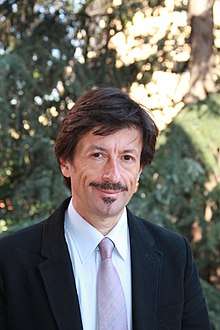Sergio Barbarossa
Sergio Barbarossa is an Italian professor, engineer and inventor. He is a professor at Sapienza University of Rome, Italy.
Sergio Barbarossa | |
|---|---|
 | |
| Born | |
| Nationality | [Italy] |
| Alma mater | [Sapienza University of Rome] |
| Scientific career | |
| Fields |
|
| Institutions | [Sapienza University of Rome] |
| Website | infocom |
Research contribution
Signal Processing
Barbarossa, together with his students, derived the uncertainty principle for signals defined over a graph and established the fundamental correspondence between uncertainty principle and sampling theory for graph signals.[1] He proposed a new definition of the Fourier Transform for signals defined over a directed graph.[2]
He derived an analytic model for the eigenfunctions of linear time-varying systems and invented the product high-order ambiguity function, an algorithm useful to estimate the parameters of multi-component polynomial-phase signals.[3] Barbarossa invented new ways to estimate the instantaneous frequency of continuous-phase signals embedded in noise, based on pattern analysis of their time-frequency representation.[4]
Radar remote sensing
Together with Farina, he introduced time-frequency distributions in the analysis of synthetic-aperture radar signals.[5] The methods are useful, in particular, for the detection and imaging of objects moving on the Earth, observed from airborne or spaceborne synthetic aperture radars. The approach was later extended to multi-antenna systems, giving rise to space-time-frequency processing.
Wireless communications
Barbarossa and collaborators derived the optimal precoding matrices for wireless communication systems,.[6][7] The proposed strategies are particularly suitable for MIMO communication systems, with channel state information at the transmit side. He contributed to the introduction of game theory to wireless communications.[8] Together with Fasano, Barbarossa introduced an optimal space-time coding technique, named Trace-Orthogonal Design, for MIMO systems with no channel information.
Mobile Edge Computing
In 2012, Barbarossa launched the idea of endowing small cell radio access points with cloud functionalities, to enable mobile users to get proximity access to cloud services within the Radio Access Network (RAN). That idea was funded by the FP7 European Project TROPIC and is now the core of Multi-Access Edge Computing (MEC). He published a series of papers on the joint optimization of communication and computation resources within the edge cloud.[9]
Awards
He was named Fellow of the Institute of Electrical and Electronics Engineers (IEEE) in 2012[12] for contributions to signal processing, sensor networks, and wireless communications.
He was named Fellow of the European Association for Signal Processing (EURASIP) in 2015 for contributions to radar remote sensing, sensor and communication networks.[13]
He received the EURASIP Technical Achievements Award in 2010 [14] for contributions to synthetic aperture radar, wireless communications and networks.
He is the co-author of the papers that received the 2000 and 2014 IEEE Best Paper Awards from the IEEE Signal Processing Society.
References
- Tsitsvero, M.; Barbarossa, S.; Di Lorenzo, P. (September 2016). "Signals on Graphs: Uncertainty Principle and Sampling". IEEE Transactions on Signal Processing. 64 (18): 4845–4860. arXiv:1507.08822. Bibcode:2016ITSP...64.4845T. doi:10.1109/TSP.2016.2573748.
- Sardellitti, S.; Barbarossa, S.; Di Lorenzo, P. (September 2017). "On the Graph Fourier Transform for Directed Graph". IEEE Journal of Selected Topics in Signal Processing. 11 (6): 796–811. arXiv:1601.05972. Bibcode:2017ISTSP..11..796S. doi:10.1109/JSTSP.2017.2726979.
- Barbarossa, S.; Scaglione, A.; Giannakis, G.B. (March 1998). "Product high-order ambiguity function for multicomponent polynomial-phase signal modeling". IEEE Transactions on Signal Processing. 46 (3): 691–708. Bibcode:1998ITSP...46..691B. doi:10.1109/78.661336.
- Barbarossa, S. (June 1995). "Analysis of multicomponent LFM signals by a combined Wigner-Hough transform". IEEE Transactions on Signal Processing. 43 (6): 1511–1515. Bibcode:1995ITSP...43.1511B. doi:10.1109/78.388866.
- Barbarossa, S.; Farina, A. (February 1992). "Detection and imaging of moving objects with synthetic aperture radar. 2. Joint time-frequency analysis by Wigner-Ville distribution". IEE Proceedings F - Radar and Signal Processing. 139 (1): 89–97. doi:10.1049/ip-f-2.1992.0011.
- Scaglione, A.; Giannakis, G. B.; Barbarossa, S. (July 1999). "Redundant filterbank precoders and equalizers. I. Unification and optimal designs". IEEE Transactions on Signal Processing. 47 (7): 1988–2006. Bibcode:1999ITSP...47.1988S. doi:10.1109/78.771047. ISSN 1053-587X.
- Scaglione, A.; Stoica, P.; Barbarossa, S.; Giannakis, G. B.; Sampath, H. (May 2002). "Optimal designs for space-time linear precoders and decoders". IEEE Transactions on Signal Processing. 50 (5): 1051–1064. Bibcode:2002ITSP...50.1051S. doi:10.1109/78.995062. ISSN 1053-587X.
- Scutari, G.; Palomar, D. P.; Barbarossa, S. (September 2008). "Competitive Design of Multiuser MIMO Systems Based on Game Theory: A Unified View". IEEE Journal on Selected Areas in Communications. 26 (7): 1089–1103. arXiv:0806.1565. Bibcode:2008arXiv0806.1565S. doi:10.1109/JSAC.2008.080907.
- Barbarossa, S.; Sardellitti, S.; Di Lorenzo, P. (November 2014). "Communicating While Computing: Distributed Mobile Cloud Computing over 5G Heterogeneous Networks". IEEE Signal Processing Magazine. 31 (6): 45–55. Bibcode:2014ISPM...31...45B. doi:10.1109/MSP.2014.2334709.
- Barbarossa, S.; Scutari, G. (May 2007). "Bio-Inspired Sensor Network Design". IEEE Signal Processing Magazine. 24 (3): 26–35. Bibcode:2007ISPM...24...26B. doi:10.1109/MSP.2007.361599.
- Di Lorenzo, P.; Barbarossa, S. (May 2013). "Swarming Algorithms for Distributed Radio Resource Allocation: A Further Step in the Direction of an Ever-Deeper Synergism Between Biological Mathematical Modeling and Signal Processing". IEEE Signal Processing Magazine. 30 (3): 144–154. Bibcode:2013ISPM...30..144L. doi:10.1109/MSP.2013.2237948.
- "2012 elevated IEEE Fellows" (PDF). IEEE Fellows Directory.
- "2015 elevated EURASIP Fellows".
- "2010 EURASIP Technical Achievements Award".